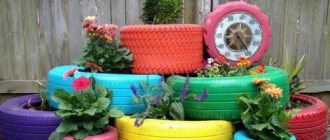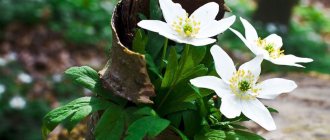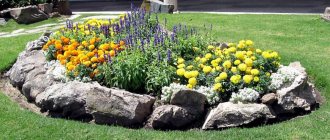Bulbous flowers will be a real surprise for you. Before flowering, they look unattractive, but if you work hard, you will have the opportunity to grow a “colorful miracle.”
Planting occurs in the autumn, starting in September. The first buds will appear only in the spring. Flowers are demanding of care, so you should not let their development take its course. Thus, they do not tolerate poor and heavy soils, prefer illuminated areas, and do not tolerate dampness.
Features of bulbous
Bulbous flowers are varied. Some bloom already at the end of winter, others only in summer. A number of plants bloom in autumn. There are also flowers that produce leaves in the spring, then disappear in the summer, and bloom again in the fall - these are colchicums.
Almost all bulbous flowers are perennials. Nutrients accumulate in their bulbs. New bulbs are planted after the leaves and flowers die.
You should not cut off the leaves immediately after flowering; you need to give them time to wither.
How to choose planting material when purchasing?
A lot depends on the choice of bulbs (or corms). Will your flowers grow, will the flowering be lush, will the plants be resistant to adverse conditions, etc.
Therefore, the choice of planting material must be carefully considered.
There are 4 basic rules for choosing planting material when purchasing bulbous plants:
- We look at the size of the corms. It’s better, of course, to take big ones. In the first season they will bloom more luxuriantly.
IMPORTANT! Remember that there are small-bulbed plants (for example, muscari and snowdrop), whose bulbs are small by themselves, and not because they are low-quality planting material.
- We carry out an external inspection of the planting material. The bulbs should be firm and “fresh” to the touch, with no signs of rot or soft spots. In addition, they should not emit a musty odor.
- We examine the bottom. It should also be dry, without rotten areas. Press lightly on the bottom with your finger. It should not be dented or pressed at all.
- Buy Fitosporin or any other fungicide immediately. Planting material is not always treated against diseases, so it is better to take care of this issue yourself.
REFERENCE. There is no need to purchase planting material for future use. Take the bulbs just before planting the flowers.
Popular types
Bulbous indoor and garden flowers can be of various types. You've probably heard many of the names mentioned in the article. All plants shown in the photo are found in the regions of our country:
Lily of the Valley (CONVALLARIA)
Everyone has seen elegant white bells with an amazing aroma. In order for lily of the valley to delight you with flowering during the Christmas holidays, it is recommended to purchase its rhizomes and plant them in mid-November.
Photo gallery
Chionodoxa
There are several popular types:
- Sardskaya - blue flowers
- Giant - flowers up to 4 cm in diameter, planting occurs in September
- Lucilias are blue, star-shaped flowers with a white center. They bloom in late winter.
Vesennik (ERANTIS)
Spring Tubergen has flowers with a diameter of 5 cm. Winter has yellow flowers with a “collar” of leaves.
Galtonia
The plant has an impressive size. The bulbs are planted in the fall, and in the summer, bells form on the peduncles - 20 or more.
Saffron (CROCUS)
In everyday life, other names for flowers of this type are often used, for example, crocus. Planted in the fall to produce plants in the spring.
As a rule, the color of the petals is yellow, but pink and pale blue shades can also be found. Flowering occurs from January to February. The most popular varieties are Pickwick (lilac with purple stripes), Vanguard (silver-pink).
Suitable for indoor growing
Indoor flowers and flowering plants with names
All flowers listed in the list “flowers with narrow leaves” are suitable for growing at home.
Here are some more bulbous indoor flowers:
- Hemanthus. Another representative of the Amaryllis family. The Hemanthus genus includes more than 40 species of plants with flowers of rich red, white and orange colors. The flowering period of hemanthus is July-August. It is best grown in bright, indirect light, but partial shade is also suitable. The optimal temperature is 18-22 degrees. Therefore, it is imperative to install an air conditioner, and also make sure that the batteries are heated properly in the winter.
- Oxalis. The plant got its name from the taste of its foliage. About 800 species of this flower are common in nature. The plant has been grown at home since the 17th century; it can also be cultivated in open ground. In Russia, the popular name for sorrel is “rabbit cabbage.” The characteristic advantages of the plant are its low maintenance requirements and attractive appearance. In Ireland, this plant is considered a national symbol and is attributed to St. Patrick. At the same time, sorrel is common in subtropical and tropical climates. It has beautiful white-pink flowers and dark brown leaves. Flowers can also be colored lilac.
- Weltheimia. This is a perennial bulbous plant that is native to South Africa. It has interesting pink flowers in the shape of narrow bells or fireworks. The optimal growing temperature is 10-14 degrees. Therefore, it is well suited for rooms that maintain a cold temperature regime, or balconies.
What an oxalis plant, with interesting purple flowers
You can list a huge number of bulbous home flowers. Many of them can be grown in open ground, but only at a certain time, then dug out from the depths of the earth for wintering.
Landing rules
Before planting, the soil should be thoroughly dug up and organic or mineral fertilizer applied. The composition of the soil should also be taken into account; if it is too acidic, liming is performed. Sand is then added and the soil is allowed to settle for a couple of days.
It is important to respect the planting deadlines! Spring garden flowers are planted from September to early October, summer flowers - in the spring.
The hole should be 2-3 times larger than the onion. The bottom is covered with river sand.
Rules for caring for them
In general, bulbous plants like well-drained soil, although some plants can grow in heavy loamy soils.
The planting depth of the bulb largely depends on the plant. Small bulbs (galanthus, crocus, narcissus, muscari) are planted closer to the surface (to a depth of 5 - 10 cm), large bulbs (narcissus, tulip, hazel grouse) are buried deeper (15 - 20 cm).
ON A NOTE . Determining the planting depth is easy. It should be 3 times the size of the bulb itself.
Choose a sunny place for planting, protected from drafts. You can arrange the flower bed in such a way that at noon the plants are protected from the scorching sun by the trees. But it is important to consider that in the shade, bulbous plants become smaller and bloom poorly.
In care, bulbous flowers love moderation. There is no need to flood the plants and apply a lot of fertilizers. By the way, it is better to use mineral supplements.
It is very important to weed, as flowers do not like being close to weeds.
Bulbs are resistant to pests, and among diseases they are mainly susceptible to fungal diseases. But, if you carry out regular preventive treatments with fungicides and do not pour too much water, then there will be no special problems with growing flowers.
Some bulbous plants (for example, gladioli) need to be dug up for the winter, but most of the representatives of this flower group are frost-resistant plants and can overwinter in the soil.
But to do this, you need to provide them with reliable shelter for the winter. Peat, fallen leaves and dry grass are quite suitable. You can first lay spunbond directly on the ground. The covering layer should be about 8 - 10 cm.
Plants need to be covered at the first frost. There is no need to do this before, as the flowers may begin to sprout. The shelter is removed in the spring, when it is completely warm and there are no morning frosts.
Rules for choosing plants
- Noble tulip varieties will be an excellent option for regular-style gardens. Garden varieties of daffodil, hazel grouse, hyacinth, and lily look great in flower beds and rural gardens. They require nutritious soil and sufficient sun.
- In small gardens and alpine hills, miniature forms of flowers should be planted. You can give preference to wild daffodils and tulips. They look no less attractive than their garden counterparts. A number of varieties grow without care and run wild near bushes and trees.
- Those dreaming of a lawn where bulbs will bloom in the spring should know that mowing the grass will only be possible from the beginning of June. Daffodils, photos of which you can see in detail, cannot be mowed within 8 weeks after flowering, otherwise they will not be able to bloom next year.
- Crocuses, which, like snowdrops, are primroses, fade most quickly.
- The first spring bloom looks most impressive in a shady garden. Anemones, chionidoxas, corydalis, and spring flowers are blooming. It is noteworthy that the presented species do not require care. After the flowers die, plant life continues in the bulb. Next spring, beautiful buds will appear again.
Galtonia whitish
Another name for this South African plant is whitish hyacinth. This is a tall snow-white flower that will fill the garden with a delicate aroma. One to two dozen bell-shaped inflorescences are formed on one plant.
Galtonia is perfect for flower beds, mixborders or container plantings.
Galtonia does not really like transplanting and blooms well in one place for 4 seasons.
| Bloom | July-September |
| Plant height | 90-120 cm |
| Planting depth | 15 cm (to the height of the bulb) |
| Distance between bulbs | 20 cm |
| Underground part | pseudobulb |
| Light requirements | |
| Purpose | |
Use in landscape design
Garden bulbous plants will decorate any garden.
Amazing lawns
A perfectly trimmed lawn is the pride of any summer resident. But if you have seen natural meadows, it is enough to plant bulbous plants on the plot, and you will get a whole sea of flowers. To help you achieve what you want:
- crocuses;
- scylla;
- daffodils;
- Chionodoxa.
In autumn, planting is done in a chaotic manner. In spring, a whole sea of flowers appears in blue, blue, pink and other shades.
Gorgeous borders
- One of the most popular design techniques is borders. So, you can use bulbous bulbs to dilute a pachysandra carpet or plant hosta bushes.
- Lilac crocus flowers will look great in the autumn garden.
- Low trees, perennials and annuals, and shrubs will be excellent neighbors for bulbous plants.
Game of colors
The selection of colors depends on the appearance of the house.
Colors come in warm and cool colors. To obtain contrasting combinations, you should combine cold and warm shades. To achieve harmony, colors that are similar in tone are used. Almost every garden uses white colors.
You should use the same color scheme in every corner of the garden to avoid oversaturation.
The basic rule is to use no more than 3 shades. There is one more nuance - harmony is achieved with a color ratio of 70:15:15.
Planting in containers
Bulbous plants can make even a small garden look luxurious. They can be planted in containers and placed near trees, on a balcony, loggia, or terrace.
The container must be large - at least 25 centimeters deep and of a similar diameter. The pot must have a hole for water drainage. When using spring-blooming flowers, choose a frost-resistant container.
Bulbs are buried in the same way as in the ground. The distance between flowers should be decent so that the plants do not interfere with each other. Requires periodic watering.
Bulbous plants will become a real decoration of the garden plot. They don't require much time or attention. Even with inconsistent care, you can enjoy delicate blooms in spring, summer and fall.
Ranunculus
Ranunculus is called the Persian (or Asian) buttercup. This is a favorite flower of florists who use it in a variety of compositions, especially peony and double varieties.
This charming plant blooms all summer. It can be grown in flower beds or as a border in well-lit areas.
Before planting, ranunculus corms are soaked in water for an hour, and after planting, the soil is watered well.
| Bloom | June August |
| Plant height | 30-60 cm |
| Planting depth | 2-5 cm |
| Distance between bulbs | 8 cm |
| Underground part | corms with corms |
| Light requirements | |
| Purpose | |











